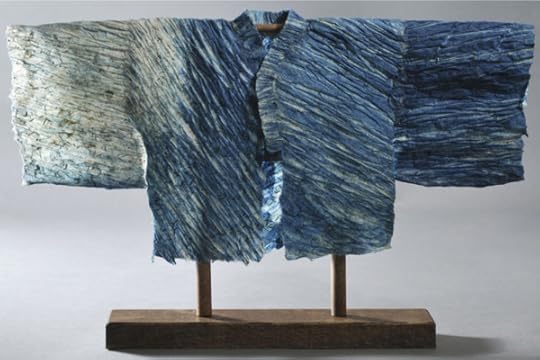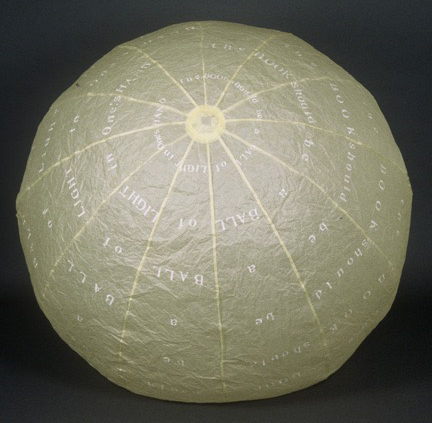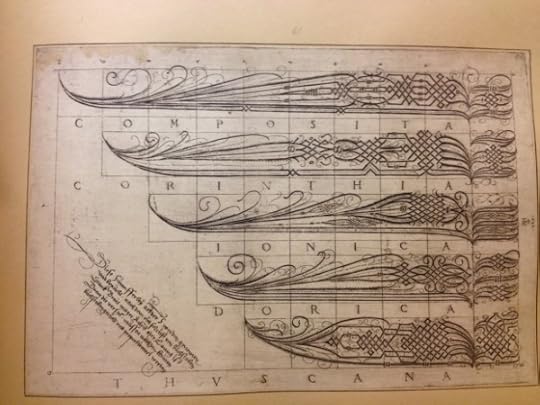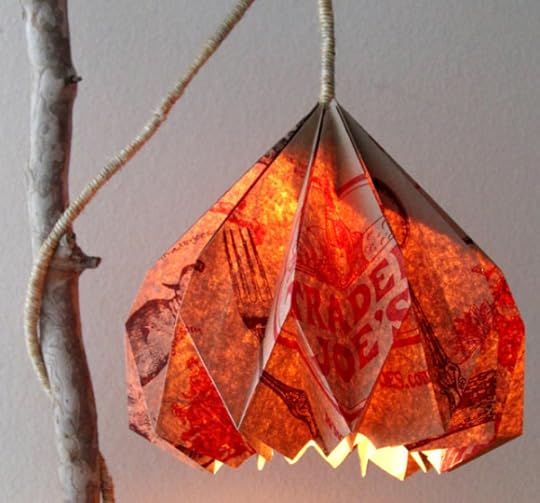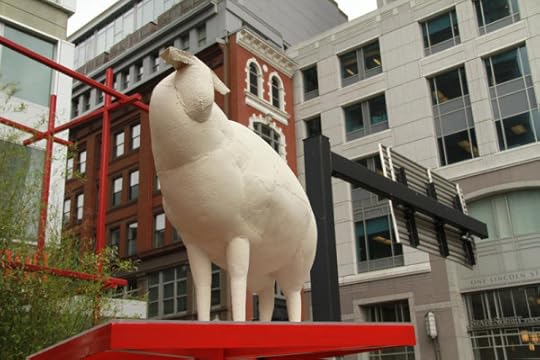Helen Hiebert's Blog, page 61
August 22, 2015
One Sheet at a Time
The Sunday Paper #69
Featured Paper of the Week: Pour Papers from Arnold Grummer’s® Papermaking
Pour papers made by creative individuals at a recent retreat which then became book covers
Arnold Grummer is one of the grandfathers of hand papermaking, and I’m so happy that I had a chance to meet him several years ago. Arnold was inducted into the International Paper Industry Hall of Fame in 2012 for his lifetime contribution as a paper educator and passed away a few weeks later. His vast number of products, books and videos makes papermaking accessible to the masses.
Sunday Paper Readers are welcome to a 15% discount on their order at Arnold Grummer’s ® Papermaking thru Sept. 1, 2015. Use code SP15 at checkout.
Arnold fashioned his pour handmold (a mould with high sides that sits in a vat with a few inches of water, making it easy to prepare pulp for one-of-a-kind sheets of paper) after the British handsheet-former he saw scientists using in paper test labs at the Institute of Paper Chemistry. He came to rely on the pour method of papermaking in his duties as curator of the Dard Hunter Paper Museum, which was housed at the Institute (the collection is now in Atlanta). Following a tour, visitors were so excited about paper that they predictably wanted to know how they could make paper themselves. To address the question in quick fashion, he’d blend up some pulp, pour it into his basement-made handmold, form a sheet and iron it dry for them to take home. His technique took five minutes from start to dry sheet.
Check out the variety of paper colors and content shown above that were made recently when Arnold’s daughter Kim Schiedermayer (who runs the company now) led 30 women in making 60 sheets of paper in two hours in a hotel conference room. And this was their first paper making experience. Sharing two vats of water and four handmolds, they made paper by ‘pouring’.
Adding ‘paper by pouring’ to the papermaker’s repertoire can simplify logistical barriers and broaden opportunities to present classes and workshops in the community. It’s another way to enrich others with the process we love. Here’s a video of Arnold showing how to make paper using a pour handmold.
————————————————————————————————————––––––––––––
In the Studio:
This week, I made these paper folders using watermarks and pulp stenciling for my upcoming Red Cliff Paper Retreat. NEWS FLASH: one spot just opened up if you can get yourself to Colorado in 3 weeks.
————————————————————————————————————––––––––––––
Cleveland area peeps: if you haven’t been to the Morgan Conservatory of Art, you are in for a real treat, especially now through September 17th when this installation by Kerry Harding graces their exhibition space. Murmuration is a site-specific installation featuring more than 1,000 paper airplanes representing starlings, “birds known for strange and beautiful flocking patterns.
Here is a lovely integration of origami and animation. Natasha Kholgade Banerjee, a graduate student at Carnegie Mellon University in Pittsburgh, was inspired to make her origami models come to life and fly, and has developed a program that lets them soar.
I find these images hard to decipher, but apparently these Star Wars scenes are intricately cut by artist Marc Hagan-Guirey from a single sheet of paper. Cool lighting!
I like these torn paper collages by Jyotirmoy Ray, which were on exhibit recently in India.
Who doesn’t love Alice in Wonderland? Check out these paper cuts by Adamova Marina that feature scenes from the story.
————————————————————————————————————––––––––––––
About Our Paper of the Week Sponsor
Arnold Grummer’s®, the company, manufactures and distributes papermaking kits & supplies for home, schools and communities. The business is managed by Kim Schiedermayer. Arnold’s daughter, in Appleton, WI. Check out these sites to learn more: Arnold Grummer’s® youtube channel, FaceBook page, Blog.
Special thanks to Arnold Grummer for sponsoring this post and for their contribution to the world of handmade paper!
————————————————————————————————————––––––––––––
 If you enjoyed reading The Sunday Paper today, why not sign up to get it delivered to your in-box each and every Sunday? Click here to subscribe (it’s free), and you’ll receive my nifty pop-up alphabet template as a thank you gift!
If you enjoyed reading The Sunday Paper today, why not sign up to get it delivered to your in-box each and every Sunday? Click here to subscribe (it’s free), and you’ll receive my nifty pop-up alphabet template as a thank you gift!
If you read this blog regularly, would you consider making a donation to support the research, writing, design and delivery of The Sunday Paper? Click on that cute paper button (I made that paper) to see how you can provide support.
And if you run a paper-related business, you might be interested in promoting your business in The Sunday Paper.
Thank you to those who have pledged your support, and enjoy your Sunday!
August 15, 2015
Tree Book Tree: a Plantable Book
The Sunday Paper #68
Paper of the Week: Envelope Paper
I enjoy taking ordinary (or not so ordinary) objects and reimagining them. I sincerely hope that letter writing will have a comeback – my BFF from childhood and I have started writing letters again – but in the meantime envelopes are fun to work with because they come in a variety of colors and sizes and other papers can easily be slipped into the pockets. This envelope folding screen (from my book Playing With Paper) has a hinge that tucks into the pockets. Cut out patterns reminiscent of stained glass, slip decorative papers inside (asanoha, a Japanese lace paper, is featured here), and set the screen in a spot where it can catch some light. Check out my pinterest board for more envelope ideas.
What have you created with envelopes? ————————————————————————————————————––––––––––––
In the Studio:
I’m developing a web page dedicated to the papers that I feature each week in The Sunday Paper. Check out The Paper Library, a growing resource for paper lovers.
————————————————————————————————————––––––––––––
Megan Singleton is a practicing artist and educator based in St. Louis, Missouri. Her recent installation is a body of work reflecting her experience navigating and researching the costal landscape, aquaculture, and aquatic plant ecology of Eastport, ME and the Passamaquoddy Bay while Artist in Residence at the Tides Museum Studio Works Program.
Megan Singleton, Interchange, an Average of Eighteen, 2015, Abaca & Wire, Dimensions variable (18 feet in length)
What a lovely book and message: Tree Book Tree is a plantable book by Pequeno Editor, a children’s book publisher in Argentina. The book demonstrates how paper products can impact the environment – literally. Its pages are made from handmade paper, it is printed with ecological ink, and jacaranda seeds are attached to the pages which are designed to sprout when the book is planted. Bookstores around Argentina are displaying planted copies of Mi Papá Estuvo en la Selva and they are germinating in store windows.
And check out this other seed project: Seeds InService: A Papermaking Institute is an initiative of Melissa Potter and Maggie Puckett to explore the intersections of the art of hand papermaking with gardening, social practice, community engagement, and creative pedagogy in The Papermaker’s Garden at Columbia College Chicago. These Seeds SEEDS INSERVICE 2014 Limited Edition Seed Packets are available here.
Check out the Fantastic Four, er I mean folds. DC Super Heroes Origami will be available soon featuring your favorite super heroes.
Paper for Water: this is a super sweet story about two entrepreneur-sisters who have raised $650,000 for water wells through origami.
————————————————————————————————————––––––––––––
 If you enjoyed reading The Sunday Paper today, why not sign up to get it delivered to your in-box each and every Sunday? Click here to subscribe (it’s free), and you’ll receive my nifty pop-up alphabet template as a thank you gift!
If you enjoyed reading The Sunday Paper today, why not sign up to get it delivered to your in-box each and every Sunday? Click here to subscribe (it’s free), and you’ll receive my nifty pop-up alphabet template as a thank you gift!
If you read this blog regularly, would you consider making a donation to support the research, writing, design and delivery of The Sunday Paper? Click on that cute paper button (I made that paper) to see how you can provide support.
And if you run a paper-related business, you might be interested in promoting your business in The Sunday Paper.
Thank you to those who have pledged your support, and enjoy your Sunday!
August 8, 2015
Cranes Not Bombs
The Sunday Paper #67
Paper of the Week: Brew Paper
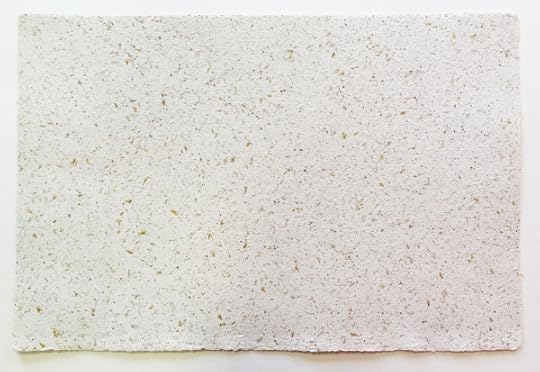
Adding items (often referred to as inclusions) to the papermaking vat is one of the simplest ways to make unique and intriguing papers. I was recently approached by a brewery to make a prototype paper with brewery waste. They sent me a bag full of wet spent grain, which I processed lightly in a blender and mixed with pulp made of cotton linter.
You can toss almost anything that floats into your vat of pulp just before making paper. Decorative elements should be small and lightweight so they don’t sink to the bottom of the vat; they should also be flat so they don’t cause problems when pressing.
I’ve seen papers made with inclusions like flower petals, coffee grounds, shredded money and confetti.
What sorts of inclusions have you added to your papers?
————————————————————————————————————––––––––––––
In the Studio:
I’m delighted to have Sandie Brayman as my assistant in the studio for the summer (and then some). She’s been a tremendous help, and one of our projects has been making short videos about various aspects in the papermaking process. She recently shot this 1.5 minute clip of me making a sheet of watermarked paper with denim pulp.
————————————————————————————————————––––––––––––
I’ve read several articles this week about communities making paper cranes on the anniversary of the dropping of the atomic bombs in Japan. After World War II ended, folded origami cranes evolved into a symbol for hope and peace through the story of Sadako Sasaki, who was exposed to radiation as an infant in the bombing of Hiroshima. Diagnosed with leukemia by age 12, she decided to fold 1,000 cranes for her wish to live and got to 644 cranes before she passed away. Her classmates finished the rest and buried her with a 1,000 crane wreath.
I was particular struck by a group in Lewisburg, Pennsylvania, who made cranes out of cut-up road maps, which organizer Nancy Cleaver said represent “The idea of connectedness to everywhere.” Their cranes are a part of a larger projct entitled “70,000 Cranes for Peace,” a worldwide campaign to commemorate the atomic bombings of Hiroshima and Nagasaki. Today marks the 70th anniversary of our dropping of the bomb on Nagasaki.
Here’s another origami-inspired product (i.e. the prototype was surely paper, but the real thing isn’t). Check out Growth, a pot that grows with your plant – no transplanting required.
Michelle Wilson recently completed a Small Plates residency at the San Francisco Center for the Book.
During that time, she completed The Last Color, this sweet little sculptural artists’ book about the color blue.
Forget the GPS! This paper cut city map by Lithuanian artist Virgilijus Trakimavicius is gorgeous enough to justify getting lost on the streets of Paris.
Listen to this radio interview by Rob Kelly, a paper engineer from Delaware who recently had an exhibition titled Midway, alluding to the space between science and art in which he works as well as the arcade influences from a carnival midway. Kelly is inspired by movement and incorporates elements of amusement, surprise, and entertainment into his work.
————————————————————————————————————––––––––––––
 If you enjoyed reading The Sunday Paper today, why not sign up to get it delivered to your in-box each and every Sunday? Click here to subscribe (it’s free), and you’ll receive my nifty pop-up alphabet template as a thank you gift!
If you enjoyed reading The Sunday Paper today, why not sign up to get it delivered to your in-box each and every Sunday? Click here to subscribe (it’s free), and you’ll receive my nifty pop-up alphabet template as a thank you gift!
If you read this blog regularly, would you consider making a donation to support the research, writing, design and delivery of The Sunday Paper? Click on that cute paper button (I made that paper) to see how you can provide support.
And if you run a paper-related business, you might be interested in promoting your business in The Sunday Paper.
Thank you to those who have pledged your support, and enjoy your Sunday!
August 1, 2015
Paper Everlasting
The Sunday Paper #66
Paper of the Week: Abaca with Embedded String

Most of you know that I love the qualities of translucency and shrinkage inherent in abaca fiber. This long fiber is a relative of the banana plant, and I like to use the premium variety that I purchase from a papermaking supplier. I beat it hard for 3 hours in my Reina beater until the pulp is smooth and silky. The natural translucency of the fiber makes it take color really well. This sheet is colored with aqueous dispersed pigment (that’s pigment in water).
One of the first papermaking techniques I learned was how to embed objects in between sheets of handmade paper during the making process. Often I embed string – hemp or linen, because they shrink and react to the abaca fibers during the drying process – to create structural sheets of paper. These sheets are strong, flexible and durable. One of my other intrigues with paper is creating objects from just one sheet. Below you see a little handbag that was created by simply stitching the seams of a rectangular sheet (on a sewing machine) and turning the bag inside out. Oh, and those diamond-shaped paper clips were embedded between the wet sheets too, to support the crocheted handles.

In the Studio: My on-line paper sale starts tomorrow! You’ll receive an e-mail link for the sale tomorrow morning and a few reminders throughout the week. I hope you’ll take a peek at the papers I’m selling – this time around it’s all abaca! I’d love to see what you create with the embedded string sheets.

————————————————————————————————————––––––––––––
This is a sweet video, but I hope you’ll also click through and read this great article about the paper industry’s fight to hold on in a digital age. The verdict is still out, but my hope is that paper will be everlasting.
Here’s a new take on an old idea: get kids interesting in engineering through hands-on learning. A team from MIT’s Computer Science and Artificial Intelligence Lab (CSAIL) and the Department of Mechanical Engineering are on a mission to get kids excited about programming by letting them write the code for a “robot garden” with dozens of fast-changing LED lights and origami robots that can crawl, swim, and blossom like flowers.
Sometimes I feel caught between the old and the new. I love innovation and the exploration of pushing materials into new realms, but I have to wonder what we are losing by being able to fabricate with the click of a button. These sculptors are doing both – using the 3D computer modeling software Pepakura to generate models – and then bringing their onscreen designs back to the real world in cardboard.
This is old news, but looks to be a lovely story from Trick of the Light Theatre in New Zealand about a boy who is apprenticed by an old bookbinder and becomes bored with his work and slapdash in its execution. A mysterious woman brings him a strange book to repair and, in his haste, he allows one page to slip free…
The Bookbinder at Fringeworld
For those of you who are into zombies (not me!), there’s a new pop-up book on the horizon: The Walking Dead: The Pop-Up Book by Stephani Danelle Perry (Author), Becca Zerkin (Creator), David Hawcock (Creator), Sally Elizabeth Jackson (Illustrator). The book is published by Insight Editions and is scheduled for release on October 27, 2015.
————————————————————————————————————––––––––––––
 If you enjoyed reading The Sunday Paper today, why not sign up to get it delivered to your in-box each and every Sunday? Click here to subscribe (it’s free), and you’ll receive my nifty pop-up alphabet template as a thank you gift!
If you enjoyed reading The Sunday Paper today, why not sign up to get it delivered to your in-box each and every Sunday? Click here to subscribe (it’s free), and you’ll receive my nifty pop-up alphabet template as a thank you gift!
If you read this blog regularly, would you consider making a donation to support the research, writing, design and delivery of The Sunday Paper? Click on that cute paper button (I made that paper) to see how you can provide support.
And if you run a paper-related business, you might be interested in promoting your business in The Sunday Paper.
Thank you to those who have pledged your support, and enjoy your Sunday!
July 25, 2015
The Floating Library
The Sunday Paper #65
Paper of the Week: Handmade Cotton/Abaca Blend
I love the fact that I can concoct my own papers, even within basic cotton and abaca fibers. Over the past year I’ve experimented with various combinations of these two pulps, to create a strong, thin, smooth opaque sheet. The sheets below are a 50/50 blend, and they are just bonus sheets that were on the other side of the mould when I was making an 18″ x 12″ decorative stenciled paper on an 18″ x 23″ mould (there was a reason for that, but I’m not going to go into the details here). I crumpled one up (similar to Japanese momigami or Korean joomchi, but more on those papers in another post. This paper crumpling reminded me of my first experience with paper sculpting, when I took a sheet of notebook paper in elementary school and crumpled and re-crumpled that sheet until it was as soft as cloth.
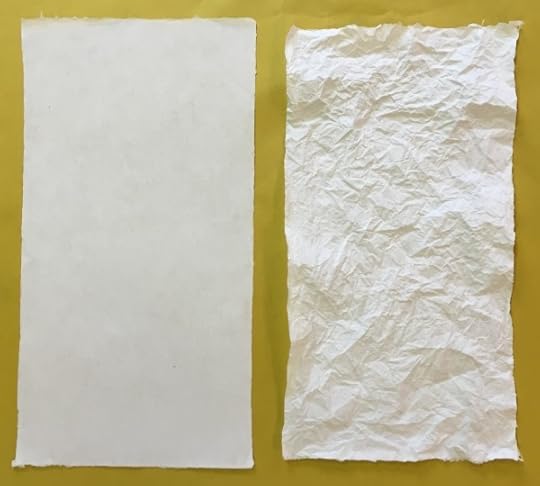
Looking at these two sheets above, it strikes me that paper is much more than a blank canvas, which invites a multitude styles, depending on the artist. I can see a drawing, the written word, a folded object, a paper cut, and so much more.
What can you see in this sheet of white paper? (please leave a comment below)
————————————————————————————————————––––––––––––
In the Studio: I made this woven dress piece as a demo during a paper weaving workshop last spring. The dark brown paper is a commercially available momi paper from Thailand.

Woven Dress © Helen Hiebert 2015, 16″ x 9″, abaca/cotton + momi paper, $175
————————————————————————————————————––––––––––––
I think that libraries are one of the best inventions of all time, and I was so excited to read about this Floating Library, a pop-up art project by Sarah Peters – it is open today on Silver Lake in Silverwood Park in St. Anthony, MN from 11 a.m. to 5 p.m. It’s filled with one-of-a-kind books crafted by artists from all over the world. You can browse the reference collection or check out a book for the afternoon – to read on your boat!
Artist-made books in plastic bags line the shelves of the Floating Library. Jennifer Simonson | MPR News
This is a great story about young entrepreneur Lisa Glover. She was assigned to research a manufacturing process and demonstrate it in a creative manner. She chose origami and created this dinosaur that attracted the attention of President Barack Obama. Then she launched a Kickstarter campaign to produce these dinosaur puzzles and raised 10x her original goal of $8,000.
Lisa Glover’s velociraptor costume
I love the cross pollination of science and art. In fact, I believe that science = art in many respects and vice versa. Here’s a personalized diagnostic toolkit using nothing more than a sheet of paper, an inkjet printer and a few well-placed folds.
It’s a paper animal kind of week. I’ll bet this 7-year old won’t forget the birthday celebration that featured a fourteen foot-long papier mache shark created by his grandfather.
Who doesn’t love a good quote? I noticed this one by Yoko Ono in The Huffington Post. I found the headline particularly amusing – you’ll have to click through to read it – but here’s the quote: “Drill a hole in the sky. Cut out paper the same size as the hole. Burn the paper. The sky should be pure blue.”
————————————————————————————————————––––––––––––
 If you enjoyed reading The Sunday Paper today, why not sign up to get it delivered to your in-box each and every Sunday? Click here to subscribe, and you’ll receive my nifty pop-up alphabet template as a thank you gift!
If you enjoyed reading The Sunday Paper today, why not sign up to get it delivered to your in-box each and every Sunday? Click here to subscribe, and you’ll receive my nifty pop-up alphabet template as a thank you gift!
If you read this blog regularly, would you consider making a donation to support the research, writing, design and delivery of The Sunday Paper? Click on that cute paper button (I made that paper) to see how you can provide support.
And if you run a paper-related business, you might be interested in promoting your business in The Sunday Paper.
Thank you to those who have pledged your support, and enjoy your Sunday!
July 18, 2015
Giant Paper Dish Cloths
The Sunday Paper #64
Featured Paper of the Week: Akatosashi from Paper Connection International
In the early 1990’s, I had the opportunity to see a Japanese papermaking exhibition at the Museum of Fine Arts in Boston, where I met Lauren Pearlman, proprietor of the soon to be Paper Connection International, which is now celebrating 20 years in business and is run by a lovely group of paperwomen. That exhibition featured 20 papermakers from Kochi Pref. (whom Lauren hosted) and they brought all of their papermaking equipment along. It was a treat to see them performing all aspects of Japanese papermaking in the museum!

Akatosashi is a kozo, or Japanese mulberry paper, hailing from the Southwest of Japan. This handmade paper measures 24.8 x 38.6 inches, has a warm hue and is approximately 30 g/m². Printmakers, both novice and experienced, love working with this paper for its strength, durability, and sophisticated finish. Many book conservators like it, especially for its tone. Try some yourself! Please note there may be slight variations due to the handmade nature of the paper; the current batch is slightly heavier, now weighing closer to 30-35 g/M² *.
Paper Connection International is offering a 10% discount on Akatosashi paper at their web shop through August 1, 2015. Just enter the code AKA10 at checkout. This discount only applies to Akatosashi, and shipping and handling are not included.
* A note about paper weights (that g/M² reference above): papers come in a variety of weights and are most commonly referred to as text weight (normal office copier paper) or cover weight (cardstock and heavier). The thickness of commercial papers are often measured with calipers and is typically given in thousandths of an inch. The weight of a paper is described using a complex system in pounds in the US and grams per square meter (g/M²) in Europe and Asia.
————————————————————————————————————––––––––––––
In the Studio: I’m back from my travels, and it feels so good to be back in my own studio. Here’s one last post from the road though. I had a terrific workshop at the Oregon College of Art & Craft last weekend. We did some dry projects as well as experimenting with abaca. This image features four participant’s lamps. Ooh la la!
Participants in my Playing With Paper Workshop at Oregon College of Art & Craft created these lamps.
————————————————————————————————————––––––––––––
The paper cuts of Maude White made it onto This is Colossal this week. Aren’t they incredible?
Check out this paper piece by Mark Bradford at the Wadsworth Atheneum in Boston. Bradford and assistants pasted layers and layers of the colored papers Bradford had brought with him from his Los Angeles studio, fixing each layer with varnish. Bradford then performed his signature subtracting operations — a kind of excavation of the built-up layers performed by sanding, peeling, and stripping away fragments of paper. I like how the writer of this article compares Bradford’s work to Sol Lewitt’s (one of my all time favorite artists) wall drawings.
Mark Bradford, Pull Painting 1
The artist Elena del Rivero does some interesting work that originated years ago in handmade paper. Her giant dish cloths (painted with dirt) survived destruction and restoration since they were originally shown: the falling towers on September 11, 2001, broke the windows of del Rivero’s studio — just across the street from the World Trade Center — and covered all of her work with a layer of dust and debris. Click the link to read more about her ongoing work.
Elena del Rivero, “[Sw:t] Home dishcloth” (2001), stitches and mending on handmade and dirtied abaca paper with watermark, 77 x 117 inches
You still have a couple of weeks to catch the show Paper Transformed at the Northwind Arts Center in Port Townsend, WA. This is an exhibition of the work of eight Western Washington artists who transform machine and handmade paper into a myriad of structures including artist books, sculpture, jewelry, baskets and other visual objects.
Mary Ashton, 4 Seasons, Winter Lit
Remember Aimee Lee, whom I featured a couple of weeks ago in The Sunday Paper? Here’s a lovely photo essay by The Plain Dealer photographer Gus Chan, who visited the Morgan Conservatory in Cleveland to cover the hanji making process.
————————————————————————————————————––––––––––––
 If you enjoyed reading The Sunday Paper today, why not sign up to get it delivered to your in-box each and every Sunday? Click here to subscribe, and you’ll receive my nifty pop-up alphabet template as a thank you gift!
If you enjoyed reading The Sunday Paper today, why not sign up to get it delivered to your in-box each and every Sunday? Click here to subscribe, and you’ll receive my nifty pop-up alphabet template as a thank you gift!
If you read this blog regularly, would you consider making a donation to support the research, writing, design and delivery of The Sunday Paper? Click on that cute paper button (I made that paper) to see how you can provide support. And if you run a paper-related business, you might be interested in promoting your business in The Sunday Paper.
Thank you to those who have pledged your support, and enjoy your Sunday!
————————————————————————————————————––––––––––––
About Our Paper of the Week Sponsor
Paper Connection International, LLC is your premier resource for fine art and specialty papers made by skilled crafts people in the East to suit the paper needs of artists and institutions around the globe. In 2015, Paper Connection is celebrating its 20th anniversary providing great paper and great paper information to the art and craft world. Discover all of their papers in their web shop, follow them on Pinterest and discover their fabulous FaceBook posts.
Special thanks to Paper Connection International for sponsoring this post and for their contribution to the world of handmade paper!
July 11, 2015
Flower Power
The Sunday Paper #62
Paper of the Week: Tracing Paper
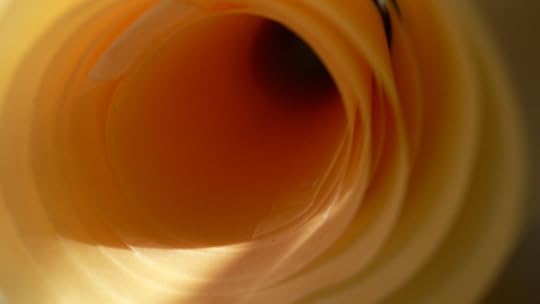
Photo credit: Wikipedia
You know the tracing paper that you can get at any art supply store? It comes on a roll, in two colors (canary yellow and white) and in varying widths from 12″ up to at least 24″ (with a few sizes in between). Now I don’t use tracing paper for what you might think – tracing – I use it to create inflatable balls. It turns out that it is just the right weight and it has just the right amount of body (for lack of a better word) and crispness to hold its form once inflated. Here’s a picture of the five foot diameter Text Ball that I created with tracing paper. I based the gore width (those sections that are pieced together to form the sphere) on the width of the roll of tracing paper. The poem (by Ezra Pound) was rubber stamped onto the sections before the sphere was assembled. It reads: “The book should be a ball of light in one’s hand”.
I learned quite a bit about tracing paper from the wikipedia entry. The following description actually gives me some insight into the translucent abaca paper that I use in much of my work: “Through mechanical ‘refining’ of the cellulose fibre to create a fibre which is highly fibrillated and gelatinous, so that in forming the sheet of paper, virtually all air is excluded from the internal structure of the paper. This method produces a very translucent and even looking paper”.
You can learn how to make this inflatable ball structure in my book, Playing With Paper.
What creative uses do you have for tracing paper? Please leave your comment below!
––––––––––––––––––––––––––––––––––––––––––––––––––––––––––––––––––––––––––
In the studio: I’m winding down my trip in the Pacific Northwest and am currently finishing up my last gig, a three-day workshop at the Oregon College of Art & Craft. Tomorrow we head home. One item of business that I took care of while here was having my new small sculptures photographed by Dan Kvitka.

I need a title for these pieces. Do you have any thoughts?
––––––––––––––––––––––––––––––––––––––––––––––––––––––––––––––––––––––––––
My friend and colleague Nick Yeager is embarking on a trip that involves a motorcycle, calligraphy and biblio-sleuthing. This sounds a bit like Zen and the Art of Motorcycle Maintenance crossed with From the Mixed Up Files of Mrs. Basil E. Frankweiler. He’s going to do research in special collections libraries and plans to document and inventory calligraphy manuals, laying the groundwork for a database for researchers, scholars and designers. Nick is running an indiegogo fundraising campaign – you’ll enjoy reading about his ideas and his travels. And then you can follow the blog Motoscribendi as he makes his journey! He says he just might swing by Colorado for a studio visit!
Harry Ransom Center, Neudorfer the Elder
I’ve typed about HiiH Lights before, but this week I had the my first visit to their new(ish) barn studio in Astoria, plus we’re staying at a friend’s house who owns these lovely lamps that they made. I love how the lotus seeds and bamboo work together in this piece!
HiiH Lights, Lotus Pod Ceiling Fixture, private commission
I’m not sure that this concept will take off, but I think if it got into the right artist’s hands, it has potential, probably more for installation work than home art, but who am I to judge? Check out Soundwall. There is a paper version.
This is pretty interesting: a physical pop-up book interacting with a video game. Maybe there is a way to get the gaming generation to interact with real books! In this case, the physical book controls the game.
This is a pretty cool ad for a Japanese whisky. Watch as sound and image blend on the surface of handmade paper. At the end, the images are enhanced with illumination.
––––––––––––––––––––––––––––––––––––––––––––––––––––––––––––––––––––––––––
If you enjoyed reading The Sunday Paper today, why not sign up to get it delivered to your in-box each and every Sunday? Click here to subscribe, and you’ll receive my nifty pop-up alphabet template as a thank you gift!
 If you read this blog regularly, would you consider making a donation to support the research, writing, design and delivery of The Sunday Paper? Click on that cute paper button (I made that paper) to see how you can provide support. And if you run a paper-related business, you might be interested in promoting your business in The Sunday Paper.
If you read this blog regularly, would you consider making a donation to support the research, writing, design and delivery of The Sunday Paper? Click on that cute paper button (I made that paper) to see how you can provide support. And if you run a paper-related business, you might be interested in promoting your business in The Sunday Paper.
Thank you to those who have pledged your support, and enjoy your Sunday!
July 4, 2015
Paper in the Guinness Book of World Records
The Sunday Paper #62
Paper of the Week: Thai Unryu
Thai Unryu is a versatile paper that I like to use for teaching. It is inexpensive and beautiful with kozo fibers running through it. It comes in a wide variety of colors (these are only a third of them), you can get it in 25″ x 37″ sheets, and a handful of colors are available on a roll. It isn’t terribly strong, but it looks great when illuminated. I often use it to add color to the shadow lantern project that I teach. I’ve also recently started using it to create double-sided sculptural papers with embedded wire.

______________________________________________________________________________
In the Studio: I’m in Portland now. It is great fun and definitely bittersweet to visit a place you used to live. But in some ways, it is business as usual. I’m catching up with artist friends, had some work shot by my photographer, and have bumped into old friends at the pool. I’m looking forward to a few days at the coast, where I’m headed today, where the highs are in the upper 60’s (there is a heat wave here in Portland).
Palmarin Merges, Here is Beauty, 2015, mixed media, fabric, and handmade paper. Photo credit: Dan Kvitka.
I gave an informal talk this week at c3:initiative, a really cool process-based residency program and arts non-profit located in the St. John’s neighborhood in North Portland. One of their missions is to support creative businesses, which they do through their business incubator, a program designed to help a budding creative business get on its feet and develop joint programs. Their first incubator business is Pulp & Deckle is a small business and working papermaking studio (how cool is that?!). Pulp & Deckle and c3initiative are currently taking applications for their papermaking residency, and you don’t have to be versed in papermaking to apply (in fact, they might be more interested if you aren’t). Check it out!
______________________________________________________________________________
Have you seen the world’s largest Chinese paper cutting? It is currently on display stretching across a full basketball court in Malaysia. Gao Xiao Dong, 51, and his wife Yan Fang, 50 used 1,200 pieces of white paper and 600 pieces of red paper, painstakingly cutting and piecing the work together on a 650m paper foundation over five years. I wonder how big their scrap pile was!
Here is the film trailer for Between the Folds, an awesome documentary about origami by Vanessa Gould. I never tire of watching this film (available on netflix) and if you haven’t seen it, you’re in for a treat!
Mapping Hand Papermaking is a great resource. It is a map of paper studios around the globe (add yours if it isn’t on there already). Be sure to poke around the Paperslurry blog for other interesting facts about paper.
Speaking of maps, Here 360 is a blog devoted to maps, and this particular post to map folding. It can be difficult to refold a map that you’ve unfolded (been there, done that). When all else fails, you can resort to the technique employed below in the crumpled city map of London.
This is an interesting article about Japanese handmade paper scraps being used as an ancient beauty secret.
______________________________________________________________________________
If you enjoyed reading The Sunday Paper today, why not sign up to get it delivered to your in-box each and every Sunday? Click here to subscribe, and you’ll receive my nifty pop-up alphabet template as a thank you gift!
 If you read this blog regularly, would you consider making a donation to support the research, writing, design and delivery of The Sunday Paper? Click on that cute paper button (I made that paper) to see how you can provide support. And if you run a paper-related business, you might be interested in promoting your business in The Sunday Paper.
If you read this blog regularly, would you consider making a donation to support the research, writing, design and delivery of The Sunday Paper? Click on that cute paper button (I made that paper) to see how you can provide support. And if you run a paper-related business, you might be interested in promoting your business in The Sunday Paper.
Thank you to those who have pledged your support, and enjoy your Sunday!
June 27, 2015
The Elephant in the Room
The Sunday Paper #61
Paper of the Week: Elephant Hide
In the late 1980’s, I moved to NYC and took my first job at Rapoport Printing Company, a commercial printer in lower Manhattan. Sidney Rapoport, who was in his 80’s at the time, had developed a process called the stonetone, a variation on the duotone, for lithographically reproducing luscious black and white photographs. We printed everything from black and white postcards to fancy annual reports. Everything was still done by hand (there was a stripping department, where “the guys” prepped all of the films for making printing plates by hand). The only computers in the place were in accounting, plus a few fancy computerized presses. Those were the days!
It was at Rapoport Printing that I discovered elephant hide paper. I don’t recall the exact details (I’m sure I remember it because of the name) but there was a huge stack of it sitting on a pallet, waiting to be bound into an annual report or something similar. I’ve used it in various projects over the years and have always been impressed by its foldability and durability. Many artists use it for origami, and it it is great for all kinds of bookbinding projects as well. Here’s a lovely review that I found in The Fold, another paper resource that you’ll want to peruse and bookmark.
—————————————————————————————————————————————
In the Studio: I’m actually out of the studio for the next couple of weeks. I spent most of the week driving to Portland, where I deposited my daughter with friends, and then headed up to Seattle, where I’m lecturing and teaching at the University of Washington.
Today, when I stopped in to pick up copies of Interluceo from Claudia Cohen (who is binding and boxing the book), I was treated to a personal showing of her latest book, which features two of my papers pictured in the center below.

—————————————————————————————————————————————
Here’s the title page for Volume Two of Claudia’s new book, Decorating Paper. Every one of the 500 paper samples are hand tipped into the book in a way that you can lift them, touch them and see their back sides. This link takes you to a blog post by Heavenly Monkey (the publisher) that features an interview with Claudia and her co-conspirator Barbara Hodgson.
—————————————————————————————————————————————
Aid for Nepal! Many of you might be familiar with Paper Road Tibet Project. Papermakers Nimto and Nima Sherpa of Tibetan Handicraft & Paper in Kathmandu were severely affected by the April 25 and May 12 earthquakes in Nepal. They are now entering the monsoon season and are in need of building materials for shelter, for rebuilding their print shop, for making repairs to the school they established, and for helping their families and neighbors. In their home village of Bigu and the two adjacent villages, all 2,000 dwellings were destroyed. Many of you may have seen, or may even own, small and colorful Tibetan prayer flags made of handmade paper. Since 2005, Nimto and Nima and company have sent more than five million of these prayers all around the world.
And now these dear friends need our prayers – and our help! We have already sent some funds and are still raising more. No amount is too small. If you wish to contribute directly, please make checks payable to: Paper Road Tibet and mail to: Tom Leech, 2 Casa Del Oro Loop, Santa Fe, NM 87508.
Please note, Paper Road Tibet relinquished its 501(c)3 status in 2003. While these contributions are not tax deductible, 100% of funds will be wired to Tibetan Handicraft & Paper, LTD. For tax deductible and credit card contributions, contact dZi Inc. And here’s a detailed earthquake report from Tibetan Handicraft & Papers, plus Tibetan Handicraft & Paper’s pre-earthquake website. Thank you, on behalf of Paper Road Tibet!

Did you see the new U-line catalog cover? Cardboard at its finest!

Do you recognize this paper? Check out this tutorial and make your own paper bag pendant light from A Piece of Rainbow. I love the clever covering for the lamp cord, too.
Speaking of paper bags, have you ever noticed that there are names printed on the bottoms of paper bags? I hadn’t… but here’s a fascinating story behind those names…
————————————————————————————————————––––––————
If you enjoyed reading The Sunday Paper today, why not sign up to get it delivered to your in-box each and every Sunday? Click here to subscribe, and you’ll receive my nifty pop-up alphabet template as a thank you gift!
 If you read this blog regularly, would you consider making a donation to support the research, writing, design and delivery of The Sunday Paper? Click on that cute paper button (I made that paper) to see how you can provide support. And if you run a paper-related business, you might be interested in promoting your business in The Sunday Paper.
If you read this blog regularly, would you consider making a donation to support the research, writing, design and delivery of The Sunday Paper? Click on that cute paper button (I made that paper) to see how you can provide support. And if you run a paper-related business, you might be interested in promoting your business in The Sunday Paper.
Thank you to those who have pledged your support, and enjoy your Sunday!
June 20, 2015
Can you say Kyoseishi?
The Sunday Paper #60
Featured Paper of the Week:: Kyoseishi from Washi Arts
In the early 1990’s I was determined to go to Japan to learn all about papermaking (I even took Japanese lessons). But alas, I ended up learning all about Western papermaking at Dieu Donné Papermill in NYC (not a bad alternative)! I am still waiting for that visit to Japan, but in the meantime I’m thankful that there are now Japanese paper suppliers in North America, such as Washi Arts, a partner of the Toronto-based The Japanese Paper Place – the world’s largest supplier of fine Japanese Papers under one roof.
Kyoseishi (kee oh ‘say shi) is a crinkle-texture Japanese paper that has a cloth like drape. This paper is treated with konnyaku* which gives it added strength and water resistance. It is great for making book covers and even clothing and comes in a variety of rich colors. Washi Arts carries a premium hand-crumpled Kyoseishi paper (some papers have the crinkle texture applied by machine) that measures 25″ x 37″.
Washi Arts is offering a 15% discount through June 30, 2015. Just enter SUNDAY2015 at check out.
Here’s a pinterest board with examples of how artists and artisans are using Kyoseishi.
* Konnyaku starch, processed from the tuberous root of the devil’s tongue plant, was traditionally used in Japan to produce a jelly‐like substance used in food. It has also been used for centuries to coat papers, especially for use in the making of kamiko paper clothing. Paper treated with konnyaku called momigami (kneaded paper) or kyoseishi (strong paper) is made both stronger and more flexible than untreated paper. Because the paper’s pores are coated it also becomes more wind and water‐resistant as well as having improved heat retention while still remaining breathable. As a lining for clothing momigami has often outlasted the textile that it lines. You can order konnyaku powder through Washi Arts too.—————————————————————————————————————————————
In the Studio: I love designing with paper, and based on what I see around the internet and the world, there are truly endless possibilities. Most of you know that I write how-to books. I’m on how-to book writing hiatus at the moment, but that doesn’t mean I’m not designing new paper projects. Here’s the latest – a how-to guide for making this Woven Paper Lantern.
Fair warning – it isn’t free – but they say the best things in life aren’t free, don’t they?
—————————————————————————————————————————————
Aimee Lee recently wove as many paper ducks as her hands could handle while at Haystack Mountain School’s Open Studio Residency (this picture was taken at Haystack, on the Maine coast). Aimee is an expert in Korean hand papermaking traditions (that duck features corded and hand woven handmade paper)! Click to read more about Aimee’s research, her classes and her book about Korean papermaking traditions.
I was delighted when a reader sent me this link to Translucides Paper Creation Studio. Check out these luminous tiles made by embedding Japanese papers in resin and glass. Wowza!
It’s a week of paper animals… bah! Paper usually isn’t considered permanent or durable, but when you think about it, it has been around for a really long time! I love it when artists can make the case for using it in public art. It does have some exceptional attributes – the fact that it is light weight is one. Artist Kyu Seok Oh’s herd of 10, cast with handmade paper, supported with steel, and coated to resist rain, are in their element amid the garden’s grasses near Chinatown Park in Boston.
This is a lovely video of the paper cut work of Jacky Cheng. She creates shapes and patterns that become incredibly complicated paperscapes over time.
This 3D printed paper battery inspired by origami (it folds into a stackable, paper device) is getting a lot of attention (and funding). Seokhun “Sean” Choi, a researcher at Binghampton University in New York, has woven origami and energy together in a super eco-friendly new medium for energy that may serve as a great device out in the field.
————————————————————————————————————––––––————
If you enjoyed reading The Sunday Paper today, why not sign up to get it delivered to your in-box each and every Sunday? Click here to subscribe, and you’ll receive my nifty pop-up alphabet template as a thank you gift!
 If you read this blog regularly, would you consider making a donation to support the research, writing, design and delivery of The Sunday Paper? Click on that cute paper button (I made that paper) to see how you can provide support. And if you run a paper-related business, you might be interested in promoting your business in The Sunday Paper.
If you read this blog regularly, would you consider making a donation to support the research, writing, design and delivery of The Sunday Paper? Click on that cute paper button (I made that paper) to see how you can provide support. And if you run a paper-related business, you might be interested in promoting your business in The Sunday Paper.
Thank you to those who have pledged your support, and enjoy your Sunday!
————————————————————————————————————––––––––––––
About Our Paper of the Week Sponsor
Washi Arts exclusively carries the exquisite papers made by tradtional Japanese paper makers as well as Japanese tools and supplies for working with washi. Washi Arts is a partner of Toronto-based The Japanese Paper Place – the world’s largest supplier of fine Japanese Papers under one roof. They have been providing knowledge and inspiration to creative enterprises around the world since 1982. Get daily creative inspiration and see what artists, architects, designers, calligraphers, binders and conservators are doing with washi on instagram, facebook, and twitter.
Special thanks to Washi Arts for sponsoring this post and for their contribution to the world of handmade paper!


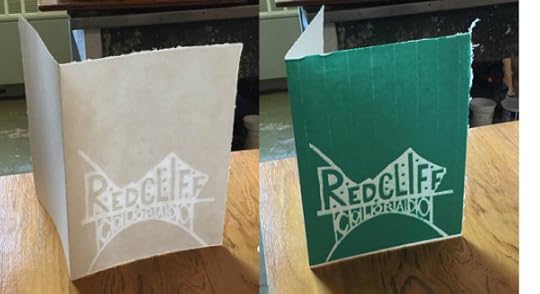
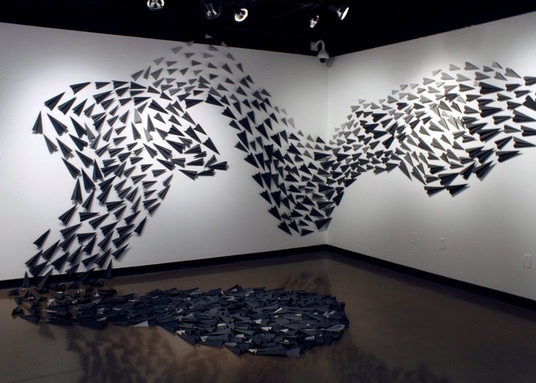


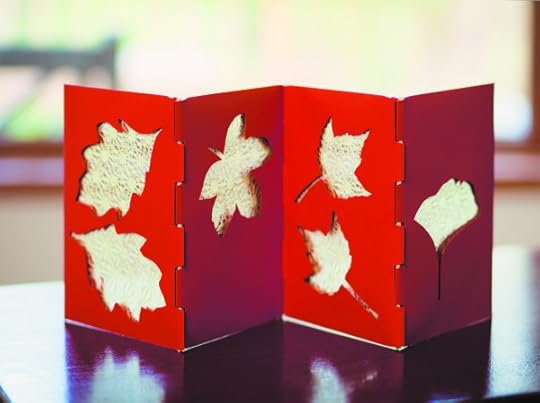




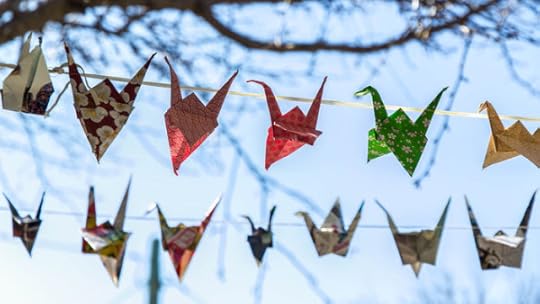
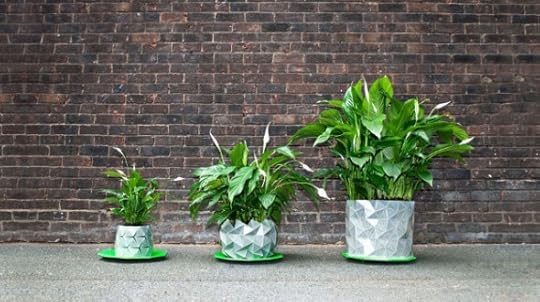

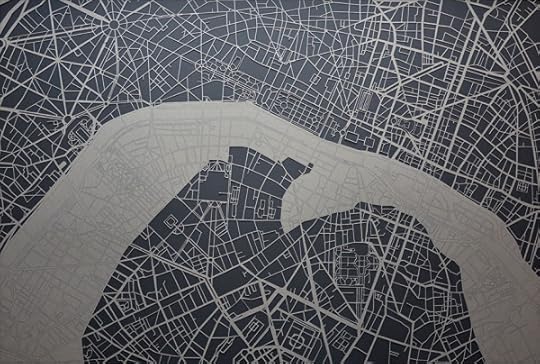

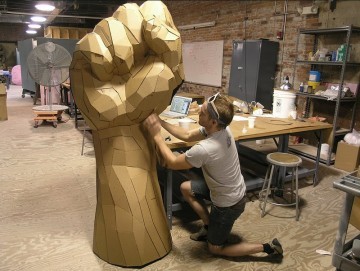

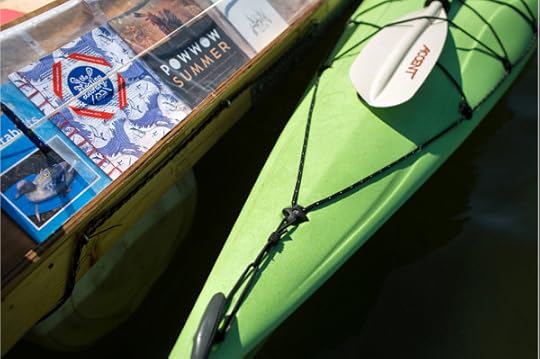
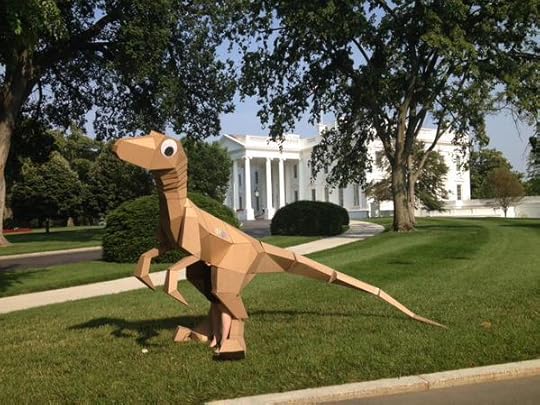



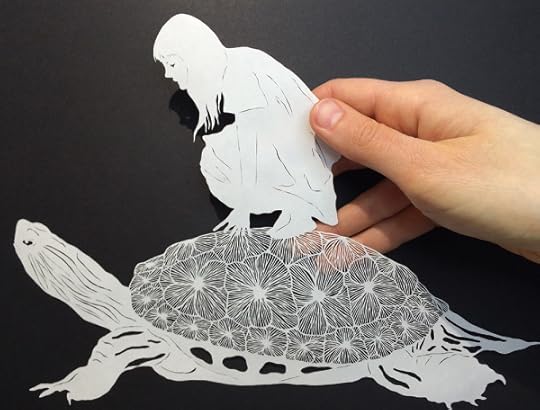

![Elena del Rivero, “[Sw:t] Home dishcloth” (2001), stitches and mending on handmade and dirtied abaca paper with watermark, 77 x 117 inches](https://i.gr-assets.com/images/S/compressed.photo.goodreads.com/hostedimages/1437300067i/15567112._SX540_.jpg)
